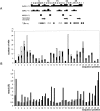Solution structure of Phrixotoxin 1, a specific peptide inhibitor of Kv4 potassium channels from the venom of the theraphosid spider Phrixotrichus auratus
- PMID: 15096626
- PMCID: PMC2286752
- DOI: 10.1110/ps.03584304
Solution structure of Phrixotoxin 1, a specific peptide inhibitor of Kv4 potassium channels from the venom of the theraphosid spider Phrixotrichus auratus
Abstract
Animal toxins block voltage-dependent potassium channels (Kv) either by occluding the conduction pore (pore blockers) or by modifying the channel gating properties (gating modifiers). Gating modifiers of Kv channels bind to four equivalent extracellular sites near the S3 and S4 segments, close to the voltage sensor. Phrixotoxins are gating modifiers that bind preferentially to the closed state of the channel and fold into the Inhibitory Cystine Knot structural motif. We have solved the solution structure of Phrixotoxin 1, a gating modifier of Kv4 potassium channels. Analysis of the molecular surface and the electrostatic anisotropy of Phrixotoxin 1 and of other toxins acting on voltage-dependent potassium channels allowed us to propose a toxin interacting surface that encompasses both the surface from which the dipole moment emerges and a neighboring hydrophobic surface rich in aromatic residues.
Figures





Similar articles
-
Structural basis of binding and inhibition of novel tarantula toxins in mammalian voltage-dependent potassium channels.Chem Res Toxicol. 2003 Oct;16(10):1217-25. doi: 10.1021/tx0341097. Chem Res Toxicol. 2003. PMID: 14565763
-
Solution structure of hpTX2, a toxin from Heteropoda venatoria spider that blocks Kv4.2 potassium channel.Protein Sci. 2000 Nov;9(11):2059-67. Protein Sci. 2000. PMID: 11152117 Free PMC article.
-
Jingzhaotoxin-XII, a gating modifier specific for Kv4.1 channels.Toxicon. 2007 Oct;50(5):646-52. doi: 10.1016/j.toxicon.2007.05.009. Epub 2007 Jun 3. Toxicon. 2007. PMID: 17631373
-
The interaction of spider gating modifier peptides with voltage-gated potassium channels.Toxicon. 2007 Feb;49(2):285-92. doi: 10.1016/j.toxicon.2006.09.015. Epub 2006 Sep 27. Toxicon. 2007. PMID: 17113615 Review.
-
ProTx-I and ProTx-II: gating modifiers of voltage-gated sodium channels.Toxicon. 2007 Feb;49(2):194-201. doi: 10.1016/j.toxicon.2006.09.014. Epub 2006 Sep 27. Toxicon. 2007. PMID: 17087985 Review.
Cited by
-
Marine Toxins Targeting Kv1 Channels: Pharmacological Tools and Therapeutic Scaffolds.Mar Drugs. 2020 Mar 20;18(3):173. doi: 10.3390/md18030173. Mar Drugs. 2020. PMID: 32245015 Free PMC article. Review.
-
Selective Targeting of Nav1.7 with Engineered Spider Venom-Based Peptides.Channels (Austin). 2021 Dec;15(1):179-193. doi: 10.1080/19336950.2020.1860382. Channels (Austin). 2021. PMID: 33427574 Free PMC article. Review.
-
Transient outward potassium current, 'Ito', phenotypes in the mammalian left ventricle: underlying molecular, cellular and biophysical mechanisms.J Physiol. 2005 Nov 15;569(Pt 1):7-39. doi: 10.1113/jphysiol.2005.086223. Epub 2005 Apr 14. J Physiol. 2005. PMID: 15831535 Free PMC article. Review.
-
Molecular and pharmacological characteristics of transient voltage-dependent K+ currents in cultured human pulmonary arterial smooth muscle cells.Br J Pharmacol. 2005 Sep;146(1):49-59. doi: 10.1038/sj.bjp.0706285. Br J Pharmacol. 2005. PMID: 15937516 Free PMC article.
-
Somatic Depolarization Enhances Hippocampal CA1 Dendritic Spike Propagation and Distal Input-Driven Synaptic Plasticity.J Neurosci. 2022 Apr 20;42(16):3406-3425. doi: 10.1523/JNEUROSCI.0780-21.2022. Epub 2022 Mar 7. J Neurosci. 2022. PMID: 35256531 Free PMC article.
References
-
- Bernard, C., Corzo, G., Mosbah, A., Nakajima, T., and Darbon, H. 2001. Solution structure of Ptu1, a toxin from the assassin bug Peirates turpis that blocks the voltage-sensitive calcium channel N-type. Biochemistry 40 12795–12800. - PubMed
-
- Blanc, E., Sabatier, J.M., Kharrat, R., Meunier, S., El Ayeb, M., Van Rietschoten, J., and Darbon, H. 1997. Solution structure of maurotoxin, a scorpion toxin from Scorpio maurus, with high affinity for voltage-gated potassium channels. Proteins 29 321–333. - PubMed
-
- Brunger, A.T., Adams, P.D., Clore, G.M., DeLano, W.L., Gros, P., Grosse-Kunstleve, R.W., Jiang, J.S., Kuszewski, J., Nilges, M., Pannu, N.S., et al. 1998. Crystallography & NMR system: A new software suite for macro-molecular structure determination. Acta Crystallogr. D 54 905–921. - PubMed
-
- Corzo, G., Escoubas, P., Stankiewicz, M., Pelhate, M., Kristensen, C.P., and Nakajima, T. 2000. Isolation, synthesis and pharmacological characterization of δ-palutoxins IT, novel insecticidal toxins from the spider Paracoelotes luctuosus (Amaurobiidae). Eur. J. Biochem. 267 5783–5795. - PubMed
MeSH terms
Substances
LinkOut - more resources
Full Text Sources
Other Literature Sources
Molecular Biology Databases

